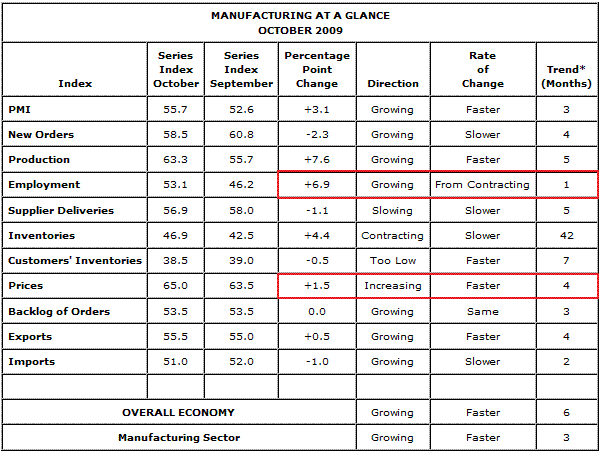Blog

Production and Employment Lead ISM Index Higher. Temporary Hiring?
The institute for supply management released the Manufacturing ISM Report on Business this morning. “Economic activity in the manufacturing sector expanded in October forrnthe third consecutive month, and the overall economy grew for the sixthrnconsecutive month” said the Institute.
The Primary Manufacturing Index was reported at 55.7, better than economist estimates for a read of 53.0 and improved from last month's 56.6. The manufacturing ISM report is at it's highest level since April 2006. The prices paid index 65.0 vs. consensus 64.0 vs. 63.5 in September. The Employment Index came in at 53.1 vs. 46.2 in September and the New Orders Index registered a print of 58.5 vs. 60.8 in September
In October, 13 of the 18 manufacturing industries reported growth.
The industries — listed in order — are: Petroleum & Coal Products;rnApparel, Leather & Allied Products; Furniture & RelatedrnProducts; Chemical Products; Computer & Electronic Products;rnTransportation Equipment; Plastics & Rubber Products; Machinery;rnFood, Beverage & Tobacco Products; Printing & Related SupportrnActivities; Fabricated Metal Products; Electrical Equipment, Appliancesrn& Components; and Paper Products.
The three industries reporting contraction in October are: Nonmetallic Mineral Products; Primary Metals; and Wood Products.

Here is what survey respondents are saying:
- “We are beginning to be affected greatly by lead-time increases onrnsemiconductor components.” (Computer & Electronic Products)
- “Still a very difficult environment — commodity increases threatenrnrecovery and don't seem to correlate with any supply/demandrnfundamentals.” (Food, Beverage & Tobacco Products)
- “Automotive demand still remains strong even after 'cash forrnclunkers.'” (Fabricated Metal Products) [indicated for the second month]
- “After several rather busy months, we are seeing the order intake for early next year soften.” (Transportation Equipment)
- “The improvement seen earlier is not holding.” (Primary Metals)
I found the comments made by Norbert J. Ore CPSM, C.P.M., the chair of the Institute for Supply Management Manufacturing Business Survey Committ, very interesting. Here is what he had to say…
“The jump in the index was driven by production and employment, with both registering significant gains. Production appears to be benefiting from the continuing strength in new orders, while the improvement in employment is due to some callbacks and opportunities for temporary workers. Overall, it appears that inventories are balanced and that manufacturing is in a sustainable recovery mode.”
We expect to see temporary hiring continue as demand fluctuates. This is a function of firms looking to keep balance sheets nimble to maintain profitability in periods of seaosonal slowness. In the short run these stints of added employment will be benefical to consumer spending, however in the long run, unless consumer spending picks up and maintains progress, we anticipate the cycle of temporary hiring will keep economic activity sporadic and month to month data volatile.
One caveat: the US economy has evolved from being driven by manfucturing to one which is lead by the services sector. So the extent to which this data has macroeconomic influence has lessened as technology has become the main source of productivity in the US.
The stronger than expected read on manufacturing employment and risingrnprices are both supportive of the Federal Reserve's dual mandate “tornpromote effectively the goals of maximum employment, stable prices, andrnmoderate long-term interest rates”. Given the fact that fixed incomerntraders are somewhat nervous about a change to the FOMC's verbiagernregarding interest rates being held near record low levels for anrn”extended period of time”, the bond market did not react well to thisrnreport. However, the uncertain long term economic outlook and the previously discussed expectations for “choppy” economic data are helping keep the rates market range bound, something that has occurred since mid-summer. I would expect the trend of no trend (range bound) to hold constant until the Federal Reserve begins open implying they are preparing to raise short term interest rates.
All Content Copyright © 2003 – 2009 Brown House Media, Inc. All Rights Reserved.nReproduction in any form without permission of MortgageNewsDaily.com is prohibited.
Latest Articles
By John Gittelsohn August 24, 2020, 4:00 AM PDT Some of the largest real estate investors are walking away from Read More...
Late-Stage Delinquencies are SurgingAug 21 2020, 11:59AM Like the report from Black Knight earlier today, the second quarter National Delinquency Survey from the Read More...
Published by the Federal Reserve Bank of San FranciscoIt was recently published by the Federal Reserve Bank of San Francisco, which is about as official as you can Read More...

Comments
Leave a Comment